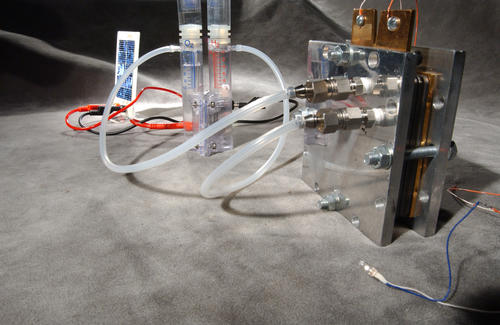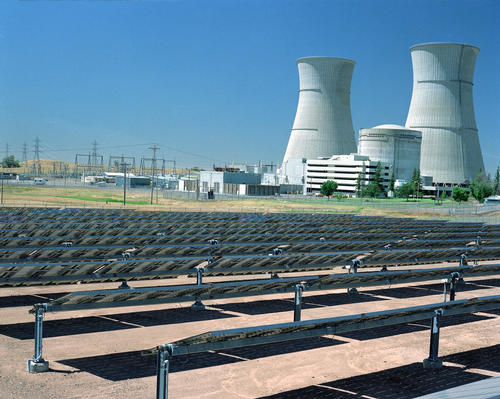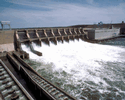Introduction
|
Learners
|
Standards
|
Process
|
Resources
|
Evaluation
|
Credits
|
Student Page
Introduction
This lesson was developed as part of my
participation in the Research Experience for Teachers (RET) program at the
University of South Florida. My laboratory studies fuel cell
applications, including the use of alternative fuels and proton exchange
membranes.
In a day and age where society heavily
relies upon nonrenewable fossil fuels for deriving energy, it is important
to explore other possible renewable energy alternatives to meet our future
needs. Thus, I tried to develop a lesson that would pique the
interest of students and lead them along this path.
Specifically, I want students to explore the applications of hydroelectric
power, wind power, nuclear power, hydrogen and fuel cells, bioenergy, and
solar power.
Learners
This lesson was developed for students in my
8th grade Integrated Science Honors class as part of our unit on energy
and energy resources.
Students will require a general knowledge of
navigating the world wide web and the use of Microsoft
PowerPoint.
Curriculum Standards
Applicable Sunshine State
Standards:
- SC.B.1.3.4: Energy conversions are never
100% efficient.
- SC.B.2.3.1: Most events in the universe
involve some form of energy transfer and that these changes almost
always increase the total disorder of the system and its surroundings,
reducing the amount of useful energy.
- SC.B.2.3.2: Knows that most of the energy
used today is derived from burning stored energy collected by organisms
millions of years ago.
- SC.D.2.3.3: Knows the positive and
negative consequences of human action on the Earth's systems.
- SC.G.2.3.1: Knows that some resources are
renewable and others are nonrenewable.
- SC.H.1.3.1: Knows that scientific
knowledge is subject to modification as new information challenges
prevailing theories and as a new theory leads to looking at old
observations in a new way.
- SC.H.1.3.2: Knows that the study of
events that led scientists to discoveries can provide information about
the inquiry process and its effects.
- SC.H.1.3.3: Knows that science
disciplines differ from one another in topic, techniques, and outcomes,
but that they share a common purpose, philosophy, and enterprise.
- SC.H.1.3.4: Knows that accurate record
keeping, openness, and replication are essential in maintaining an
investigator's credibility with other scientists and society.
- SC.H.1.3.5: Knows that a change in one or
more variables may alter the outcome of an investigation.
- SC.H.1.3.6: Recognizes the scientific
contributions that are made by individuals of diverse backgrounds,
interests, talents, and motivations.
- SC.H.1.3.7: Knows that when similar
investigations give different results, the scientific challenge is to
verify whether the differences are significant by further study.
- SC.H.3.3.4: Knows that technological
design should require taking into account constraints such as natural
laws, the properties of the materials used, and economic, political,
social, ethical, and aesthetic values.
- SC.H.3.3.5: Understands that
contributions to the advancement of science, mathematics, and technology
have been made by different kinds of people, in different cultures, at
different times, and are and intrinsic part of the development of human
culture.
- SC.H.3.3.6: Knows that no matter who does
science and mathematics or invents things, or when and where they do it,
the knowledge and technology that result can eventually become available
to everyone.
This lesson also requires that
students:
- Utilize critical thinking
- Participate in creative production and
problem-solving
- Work cooperatively within a team
- Use process skills such as comparison and
inference
- Demonstrate effective research
skills
Process
This lesson will require about one week of
class time:
- One to two 50-minute class periods for
research
- Two 50-minute class periods to generate
PowerPoint presentation
- One to two 50-minute class periods for
group presentations
Students will complete research on the
following alternative energy resources:
| 1. Hydroelectric Power
2. Wind Power
3. Nuclear Power
4. Hydrogen and Fuel Cells
5. Bioenergy
6. Solar Power
Students should, at minimum,
cover the following topics.
(a) What is this energy
resource?
(b) Where does the energy resource
come from?
(c) How does this energy resource
work?
(d) What are the advantages and
disadvantages of this energy resource?
(e) Is this energy resource cost
effective?
(f) Is this energy resource
environmentally friendly?
(g) Are there limitations to the
feasibility of this energy resource?
They will be required to submit SIX
(6) Research Verification Forms, one for each energy
resource.
Students may find the following
websites useful during their research. This is NOT an
all-inclusive list. Feel free to utilize other websites and/or
resources as well.
http://www.energy.gov/
http://www.eere.energy.gov/
http://www.howstuffworks.com/
http://www.crest.org/
http://www.nrel.gov/
http://www.energyquest.ca.gov/
http://www.renewableenergy.com/
http://www.dsireusa.org/
Students then will consider the
following:
| If we are to have sufficient energy in
the future, viable alternatives must be sought now. Your
organization, The United States Department of Energy, strives
to "protect our national and economic security by promoting a
diverse supply and delivery of reliable, affordable, and
environmentally sound energy." While the Department of
Energy would like for Congress to fund all six energy
programs, Congress is only willing to fund THREE (3).
After thoroughly researching the aforementioned energy
alternatives, your group will need to select the three energy
alternatives that seem the most promising and convince the
Congress to fund them. Recall that the Congress has its
own constituents to answer to, so your rationale for funding
each energy program must be sound.
Your group (2-3 individuals)
will need to create a PowerPoint presentation that depicts the
following:
(a) An overview of each energy
resource- what it is, where it comes from, and how it
works.
(b) The advantages and
disadvantages of each energy resource (Be honest!
Almost all alternatives have some disadvantages.)
(c) Ten reasons (at minimum) why
your choices are more viable than those not
selected.
Additionally, your PowerPoint
presentation should meet the following criteria:
(a) Be free from spelling and
grammatical errors.
(b) Use a font that is easy to
read, considering both type and size.
(c) Utilize a contrasting font
and background color.
(d) Include graphics.
Students will present their
PowerPoint presentation during one of two set aside class
sessions.
In order for this lesson to be
successful, the teacher must feel comfortable with basic
computing skills, including the use of the Internet,
PowerPoint, and a LCD projector and be comfortable with
students working collaboratively in groups. The teacher
must secure class time in the media center and/or computer lab
so students will be able to complete their research and
PowerPoint presentations. The teacher should circulate
and monitor students for progress and ensure that each student
is making a
contribution. | |
Resources Needed
- A computer with internet access and
Microsoft PowerPoint for each student (and at minimum for each group of
2-3 students.
- LCD Projector
Useful websites:
Evaluation
Evaluation will be made by rubric. The
rubric I have used is listed below:
| The Energy Crisis (200 points
possible)
Research Verification Forms (10
points per form; 60 points possible)
Form 1. (a) _____ (b)
_____ (c) _____ (d) _____ (e) _____ (f)
_____ (g) _____
Form 2. (a) _____ (b)
_____ (c) _____ (d) _____ (e) _____ (f)
_____ (g) _____
Form 3. (a) _____ (b)
_____ (c) _____ (d) _____ (e) _____ (f)
_____ (g) _____
Form 4. (a) _____ (b)
_____ (c) _____ (d) _____ (e) _____ (f)
_____ (g) _____
Form 5. (a) _____ (b)
_____ (c) _____ (d) _____ (e) _____ (f)
_____ (g) _____
Form 6. (a) _____ (b)
_____ (c) _____ (d) _____ (e) _____ (f)
_____ (g) _____
PowerPoint Presentation (5
points per blank; 75 points possible)
Choice 1
Choice 2
Choice 3
What it
is
_____
_____
_____
Where it comes
from
_____
_____
_____
How it
works
_____
_____
_____
Advantages
_____
_____
_____
Disadvantages
_____
_____
_____
Ten reasons why your choices are more
viable than those not selected (3 points each; 30 points
possible) _____
Technical (5 points each; 20
points possible)
Free from spelling and grammatical
errors (5 points) _____
Font- size and type appropriate (5
points) _____
Contrasting font and background colors
(5 points) _____
Graphics (5 points)
_____
Oral Presentation (5 points
each; 15 points possible)
Evidence of preparation (5
points) _____
Adequate volume/Visual contact (5
points) _____
Participation (5 points)
_____ |
Credits & References
| This lesson was generated as part of my
participation in the Research Experience for Teachers (RET) program
at The University of South Florida.
I would like to thank Dr. Carlos Smith
for organizing the RET program. I would also like to thank Dr.
John Wolan and his graduate students Benji, Tim, Ala'a, and Meralys for welcoming me in their laboratory.
__________________________________________________________________________
Photographs are courtesy of
http://www.nrel.gov with credit
given to individual photographers.
Individual Photograph Credits:
Corn Harvest & Stover: Bob Allen
Hydrogen Fuel Cell, Nuclear Reactor,
and Wind Farm: Warren Getz
Solar Panels: PowerLight Corporation
Hydroelectric Powerplant: U.S. Army
Corps of Engineers
__________________________________________________________________________
Link
to WebQuest Page
Email
Author
We all benefit by being generous with
our work. Permission is hereby granted for other educators to copy
this WebQuest, update or otherwise modify it, and post it elsewhere
provided that the original author's name is retained along with a
link back to the original URL of this WebQuest. On the line after
the original author's name, you may add Modified by (your name)
on (date). If you do modify it, please let me know and provide
the new URL. |
Last updated on 7/7/05. Based on a template from
The WebQuest Page
|








